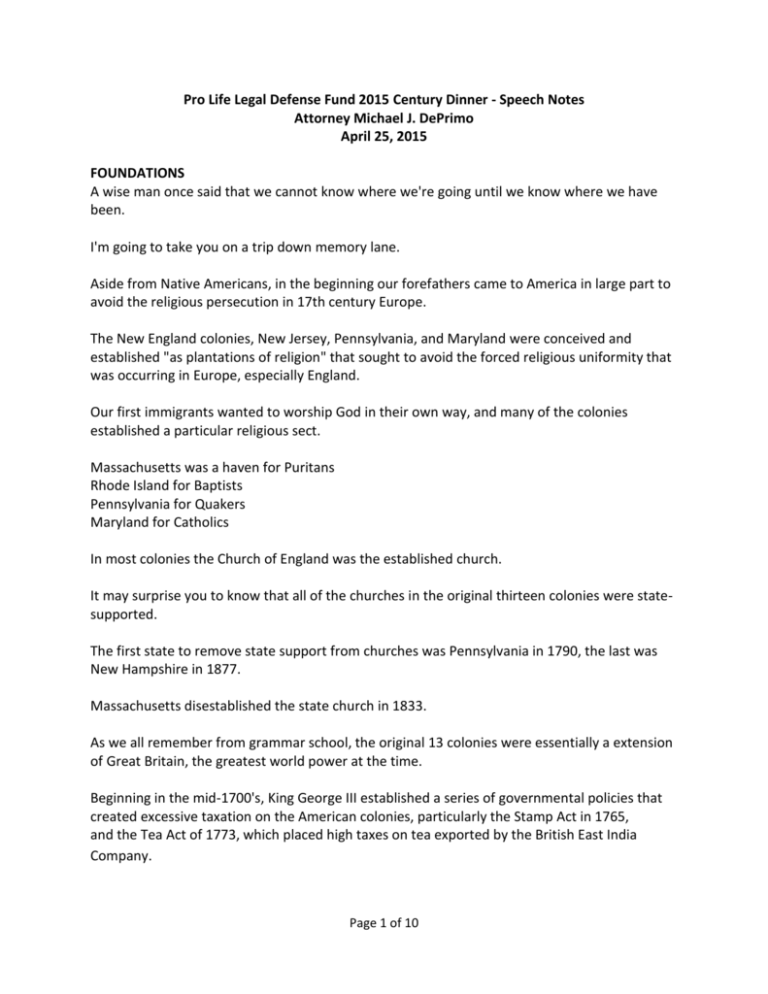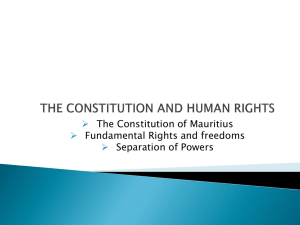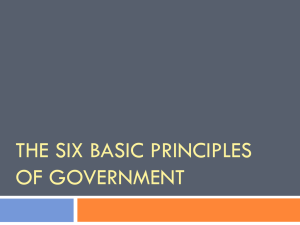
Pro Life Legal Defense Fund 2015 Century Dinner - Speech Notes
Attorney Michael J. DePrimo
April 25, 2015
FOUNDATIONS
A wise man once said that we cannot know where we're going until we know where we have
been.
I'm going to take you on a trip down memory lane.
Aside from Native Americans, in the beginning our forefathers came to America in large part to
avoid the religious persecution in 17th century Europe.
The New England colonies, New Jersey, Pennsylvania, and Maryland were conceived and
established "as plantations of religion" that sought to avoid the forced religious uniformity that
was occurring in Europe, especially England.
Our first immigrants wanted to worship God in their own way, and many of the colonies
established a particular religious sect.
Massachusetts was a haven for Puritans
Rhode Island for Baptists
Pennsylvania for Quakers
Maryland for Catholics
In most colonies the Church of England was the established church.
It may surprise you to know that all of the churches in the original thirteen colonies were statesupported.
The first state to remove state support from churches was Pennsylvania in 1790, the last was
New Hampshire in 1877.
Massachusetts disestablished the state church in 1833.
As we all remember from grammar school, the original 13 colonies were essentially a extension
of Great Britain, the greatest world power at the time.
Beginning in the mid-1700's, King George III established a series of governmental policies that
created excessive taxation on the American colonies, particularly the Stamp Act in 1765,
and the Tea Act of 1773, which placed high taxes on tea exported by the British East India
Company.
Page 1 of 10
This in turn prompted the Boston Tea Party, in which patriots destroyed an entire shipment of
East India Tea by casting it into the Boston harbor. (1773)
It also prompted the slogan, "No taxation without representation" which, finally, led to the
American Revolutionary War.
As we all know, the United States came into existence on July 4, 1776 through the Declaration
of Independence.
The Declaration is our country's founding document, and laid down the principles on which the
new nation was formed.
First, the Declaration explicitly cited the laws of nature and nature's God as the legal authority
allowing the colonies to separate from England.
It specifically acknowledged that certain truths were SELF-EVIDENT, meaning not subject to
debate.
Among those truths was the first principles that ALL MEN ARE CREATED EQUAL
That they are endowed by their CREATOR with certain UNALIENABLE RIGHTS
That among those rights are LIFE, LIBERTY, AND THE PURSUIT OF HAPPINESS
That Governments are instituted among men to secure those rights;
And that, when any Government becomes destructive to those ends, it is the right of the
people to alter or abolish it.
The Declaration concludes with an appeal to the Supreme Judge of the world and a firm
reliance on Divine Providence.
The signors pledged their lives, fortunes, and sacred honor to each other in support of the
Declaration.
During the Revolutionary War, the United States was governed by several versions of what was
called the Articles of Confederation.
The Articles were unsuccessful, and in 1787 a constitutional convention took place in
Philadelphia over a period of four months.
At one point during the convention, at an impasse, the elder statesmen Benjamin Franklin
reminded the participants of who the true architect of governing law really is. He said,
Page 2 of 10
In this situation of this Assembly, groping as it were in the dark to find political truth, and scarce
able to distinguish it when presented to us, how has it happened, Sir, that we have not once
thought of humbly applying to the Father of lights to illuminate our understandings?
In the beginning of the Contest with G. Britain, when we were sensible of danger we had daily
prayer in this room for the divine protection.
Our prayers, Sir, were heard, and they were graciously answered. All of us who were engaged in
the struggle must have observed frequent instances of a superintending providence in our
favor.
And have we now forgotten that powerful friend? I have lived, Sir, a long time, and the longer I
live, the more convincing proofs I see of this truth- that God governs in the affairs of men.
And if a sparrow cannot fall to the ground without his notice, is it probable that an empire can
rise without his aid?
We have been assured, Sir, in the sacred writings, that "except the Lord build the House they
labour in vain that build it."
I firmly believe this; and I also believe that without his concurring aid we shall succeed in this
political building no better than the Builders of Babel.
The result of the convention was the United States Constitution--the first written constitution in
history.
It created a federalism form of government, meaning that two forms of government, state and
federal, governed the same territory.
The states had the general authority to govern within its borders; the federal government was
given very limited powers.
As we know, the federal government has three independent branches, the Legislative,
Executive, and the Judicial.
The Constitution gives most attention to the Legislative Branch and a considerable amount to
the Executive. Very little attention is given to the Judicial Branch.
During the ratification debates, Alexander Hamilton said that the Judicial Branch was the
weakest and least dangerous of the three branches because it has "no influence over either the
sword or the purse, ... It may truly be said to have neither FORCE nor WILL, but merely
judgment." (Federalist Papers 78)
The Constitution was ratified by the states in 1788 and went into effect in 1789.
Page 3 of 10
In 1791 certain amendments to the Constitution were ratified. They are known as the Bill of
Rights and include the first Ten Amendments.
The very first amendment guarantees personal freedom. It says:
Congress shall make no law respecting an establishment of religion, or prohibiting the free
exercise thereof; or abridging the freedom of speech, or of the press; or the right of the people
peaceably to assemble, and to petition the government for a redress of grievances.
Notice that the application of the amendment was limited to Congress--the federal
government.
At the time, each state had its own constitution that offered similar protections.
Our federal constitution is now 226 years old.
In 1803, during his presidency, Thomas Jefferson said "Our peculiar security is in the possession
of a written Constitution. Let us not make it a blank paper by construction."
In 1804, in the seminal case of Marbury v. Madison, Chief Justice John Marshall firmly
established the principle of judicial review, holding that the Courts had the authority to review
acts of Congress and declare them unconstitutional.
STUDY OF LAW
Up until the late 1800's, students studied law by studying the laws that were already
established. In essence, they were told what the law was by their instructors.
One of the most widely used textbooks was William Blackstone's Commentaries on the Laws of
England. In the mid-1700's Blackstone had assimilated all of the common laws of England.
Common law is law derived from custom or judicial precedent.
Importantly, cases decided by judges were not law in themselves; the judges' opinions were
merely evidence of what the law was.
It was not the role of the judge to make subjective judgments but rather merely to declare the
law as it existed. Thus, there was no such thing as judge-made law in the 18th and 19th
centuries.
But the study of law changed in the late 1800’s when a law professor named Christopher
Columbus Langdell introduced the case method of study at Harvard.
Page 4 of 10
The case method studies law pragmatically.
It studies the opinions of judges rather than, as before, being instructed in what the law is.
It requires students to use their own reason to understand how a particular law might apply in
a given case.
It is also called the Socratic Method. Some here may remember the movie the "Paper Chase" in
which Professor Charles Kingsfield instructed through the use of questioning his students.
In actuality, the case method of study elevated the reasoning and opinion of the judges over
the rules of law that had existed for centuries.
Eventually, cases were no longer evidence of law but became law in and of itself.
Forty years after Langdell introduced the case method at Harvard, then Chief Justice of the
United Stated Charles Evans Hughes said,
"We are under a written Constitution, but the Constitution is what the judges say it is."
Ever since, the United States has been ruled by an oligarchy of nine men and women called the
Supreme Court.
In 1943, in the case of Board of Education v. Barnett, the Supreme Court issued one of its best
opinions protecting religious and natural freedom. It said,
"If there is any fixed star in our constitutional constellation, it is that no official, high or petty,
can prescribe what shall be orthodox in politics, nationalism, religion, or other matters of
opinion or force citizens to confess by word or act their faith therein."
Only four years later, that decision began to erode.
In 1948, in the case of McCollum v. Board of Education, the Supreme Court ruled that religious
instruction in public schools was unconstitutional, holding that, “in the words of Jefferson, the
clause against establishment of religion by law was intended to erect a wall of separation
between church and state.”
That case took Jefferson's statement out of context and turned it on its head.
In a letter written in 1802 to the Danbury Baptist Association, Jefferson said,
Believing with you that religion is a matter which lies solely between Man & his God, that he
owes account to none other for his faith or his worship,
Page 5 of 10
that the legitimate powers of government reach actions only, & not opinions,
I contemplate with sovereign reverence that the religion clauses of the First Amendment build a
wall of separation between Church & State.
In essence, Jefferson said that the Establishment Clause was designed to protect the people
from government overreaching in matters of religion.
Nothing in the letter hints that Jefferson saw the Establishment Clause as forbidding religion's
influence on government.
Over the next several decades religious freedom began to erode.
In 1962, in the case of Engel v. Vitale, the Supreme Court ruled that public school-composed
prayers are unconstitutional.
One year later, in 1963, the High Court ruled that public school-sponsored bible reading is
unconstitutional.
In 1987, the Supreme Court ruled that the teaching of creation as set forth in the bible could
not be taught in public schools.
In 1980, in the case of Stone v. Graham, the Supreme Court made one its most foolish
pronouncements ever.
It said the posting of the Ten Commandments on public school walls was unconstitutional.
Its reasoning?
QUOTE: "Posting of religious texts on the wall serves no educational function. If the posted
copies of the Ten Commandments are to have any effect at all,
it will be to induce the schoolchildren to read, meditate upon, perhaps to venerate and obey,
the Commandments."
Think about that for a moment. Essentially, the Court said that there is no educational value in
teaching children that certain laws proceed from the Creator.
What a far cry from the Declaration of Independence, which solemnly proclaimed that our
Creator endows us with certain unalienable rights.
By the way, the very first law requiring public education in America was passed right here in
Massachusetts in 1647. It was called the Old Deluder Satan Act.
Page 6 of 10
Its purpose was teach children to read. Why? Because that old deluder Satan tried to keep men
from the knowledge of the Scriptures.
Today, public schools teach moral relativism and situational ethics. They teach that there is no
objective standard of truth, and everything is open to debate.
Think as you will, do as you feel. That is, so long as you think the way the government tells you
to think.
Paralleling
During the same period the Supreme Court was cleansing religion from the public schools, it
was issuing decisions dismantling legislatively-imposed morality.
This dismantling can be traced to 1965 in the case of Griswold v. Connecticut.
There, a Connecticut statute had prohibited the use of artificial contraception.
Though the law was rarely enforced, the Supreme Court declared that it violated the
constitutional right to privacy.
Nothing in the Constitution's text speaks of a general right to privacy. And, prior to Griswold,
the High Court had never used the term.
So, where did it come?
The Supreme Court in Griswold said the right to privacy emanates from the penumbras of the
Bill of Rights.
Did you get that?
The right to privacy emanates from the penumbras of the Bill of Rights.
A penumbra is a shadow.
For instance, when we see less than a full moon in the sky, the remainder of the moon is hidden
in the penumbra--the shadow.
Of course, we can see the full moon at certain times of the month.
Unlike the full moon, the full contours of the right to privacy cannot be known because they are
hidden.
And only Supreme Court Justices can see them.
Page 7 of 10
This, of course, means that anything can be a constitutional right if the justices say so.
The right to abortion is hidden in the penumbras.
The right to homosexual sodomy is hidden in the penumbras.
Later this year we are likely to see the Supreme Court find the right to same sex marriage
hidden in the penumbras.
Thomas Jefferson's fear has become real:
the Supreme Court has made Constitution a blank piece of paper by construction.
Of course, competing rights are now on a collision course.
Long-recognized rights of conscience, as so well articulated in the Barnette case, are giving way
to newly recognized rights that clash with sincerely held religious beliefs.
Thus, the Obama administration says that the Catholic Sisters of the Poor must provide
contraception to its employees.
The state of Oregon fined a Christian baker for refusing to make a cake for a same sex wedding.
A judge in Washington State held that a Christian florist violated anti-discrimination laws when
she refused to provide flowers for a same-sex wedding.
And both New York and New Jersey have fined Christians for refusing to allow same-sex
marriages in their banquet facilities.
Folks, religious persecution in America is here.
We won't see beheadings but we will see increased fines and perhaps even jail time for people
who refuse to violate their consciences.
The America we've all known and loved is gone.
And it's not coming back in our lifetimes.
Like the ancient nation of Israel as described in the Book of Judges, we have forgotten God.
Today, many men and women have a form of godliness but deny its power.
The Bible describes these people as always learning but never able to discern the truth.
Page 8 of 10
In large part, it is people like this who are in control our government today.
HOW DID WE GET HERE
You may be asking yourself,
How did we get from the morally-consistent 1950's, when American life was exemplified by
Father Knows Best
Leave it to Beaver
and
The Donna Reed Show.
When America's slogan was baseball, apple pie, and Chevrolet
When students got in trouble for nothing more than chewing gum, throwing paper airplanes, or
whispering in class?
To the Sixties and beyond where almost all wholesome moral constraint has been cast off?
Some people may think it is an unfortunate coincidence.
Others believe it was a carefully orchestrated, sinister scheme.
Dr. Judith Reisman, who has made a career of studying the negative effects of pornography,
believes it all started in the 1940s.
According to Reisman, it began with Alfred Kinsey and the elites. It the 40s Kinsey purportedly
conducted several studies that he parlayed into two books known collectively as the Kinsey
Report.
These books created outrage because they challenged American norms of sexual behavior.
According to Kinsey, what Americans did behind closed doors was a far cry from what they
claimed was acceptable moral behavior.
But according to Reisman, what Kinsey failed to disclose was that the people who were
interviewed for his so-called study were prison inmates, homosexuals, pedophiles, and
prostitutes.
Also, according to Reisman, Kinsey encouraged pedophiles to abuse children in order to make
"findings" on the sexual desires of children.
Finally, according to Reisman, Kinsey was bi-sexual and promiscuous.
Page 9 of 10
In the mid-1950's, it appears Kinsey worked with the American Law Institute to revise the
Model Penal Code.
The revised model code deleted many crimes based on sexual behavior.
Over time, the model code's influence on sex crimes made its way into state criminal codes.
So was the dismantling of sexual crimes and the loosening of morality a mere coincidence? You
decide.
Remedy
So, what do we do?
First, we must, as did our forefathers, mutually pledge our lives, our fortunes, and our sacred
honor.
Second, we must stand up and out against the overreaching of government, state and federal.
Third, we must think generationally.
It took fifty years to get us to this point and we should not believe we can reverse the trends in
1, 5 or even 10 years.
This must be a long term strategy.
Fourth, we must counteract the public schools, the media, and political activists by teaching our
children and grandchildren what is true, right, and good.
The Bible is a lamp to our feet, a light to our path.
It is the truth that shall set us free.
Fifth, we must be willing to suffer.
Finally, we must rely on our faithful friend, our God.
Like Ben Franklin, we must say, "unless the Lord builds the house, he who builds it, builds it in
vain.
God bless you and God bless America.
Page 10 of 10










